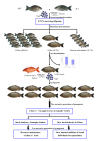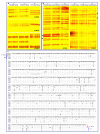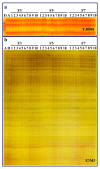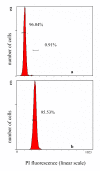A novel nucleo-cytoplasmic hybrid clone formed via androgenesis in polyploid gibel carp
- PMID: 21439093
- PMCID: PMC3072332
- DOI: 10.1186/1756-0500-4-82
A novel nucleo-cytoplasmic hybrid clone formed via androgenesis in polyploid gibel carp
Abstract
Background: Unisexual vertebrates have been demonstrated to reproduce by gynogenesis, hybridogenesis, parthenogenesis, or kleptogenesis, however, it is uncertain how the reproduction mode contributes to the clonal diversity. Recently, polyploid gibel carp has been revealed to possess coexisting dual modes of unisexual gynogenesis and sexual reproduction and to have numerous various clones. Using sexual reproduction mating between clone D female and clone A male and subsequent 7 generation multiplying of unisexual gynogenesis, we have created a novel clone strain with more than several hundred millions of individuals. Here, we attempt to identify genetic background of the novel clone and to explore the significant implication for clonal diversity contribution.
Methods: Several nuclear genome markers and one cytoplasmic marker, the mitochondrial genome sequence, were used to identify the genetic organization of the randomly sampled individuals from different generations of the novel clone.
Results: Chromosome number, Cot-1 repetitive DNA banded karyotype, microsatellite patterns, AFLP profiles and transferrin alleles uniformly indicated that nuclear genome of the novel clone is identical to that of clone A, and significantly different from that of clone D. However, the cytoplasmic marker, its complete mtDNA genome sequence, is same to that of clone D, and different from that of clone A.
Conclusions: The present data indicate that the novel clone is a nucleo-cytoplasmic hybrid between the known clones A and D, because it originates from the offspring of gonochoristic sexual reproduction mating between clone D female and clone A male, and contains an entire nuclear genome from the paternal clone A and a mtDNA genome (cytoplasm) from the maternal clone D. It is suggested to arise via androgenesis by a mechanism of ploidy doubling of clone A sperm in clone D ooplasm through inhibiting the first mitotic division. Significantly, the selected nucleo-cytoplasmic hybrid female still maintains its gynogenetic ability. Based on the present and previous findings, we discuss the association of rapid genetic changes and high genetic diversity with various ploidy levels and multiple reproduction modes in several unisexual and sexual complexes of vertebrates and even other invertebrates.
Figures






References
-
- Avise JC. Clonality: The Genetics, Ecology, and Evolution of Sexual Abstinence in Vertebrates. Oxford: Oxford University Press; 2008.
-
- Schlupp I. The evolutionary ecology of gynogenesis. Annu Rev Ecol Syst. 2005;36:399–417. doi: 10.1146/annurev.ecolsys.36.102003.152629. - DOI
-
- Lamatsch DK, Stock M. In: Lost Sex. I Schon, editor. Springer Science+Business Media B.V; 2009. Sperm-dependent parthenogenesis and hybridogenesis in teleost fishes; pp. 399–432. full_text.
LinkOut - more resources
Full Text Sources
Research Materials
Miscellaneous

